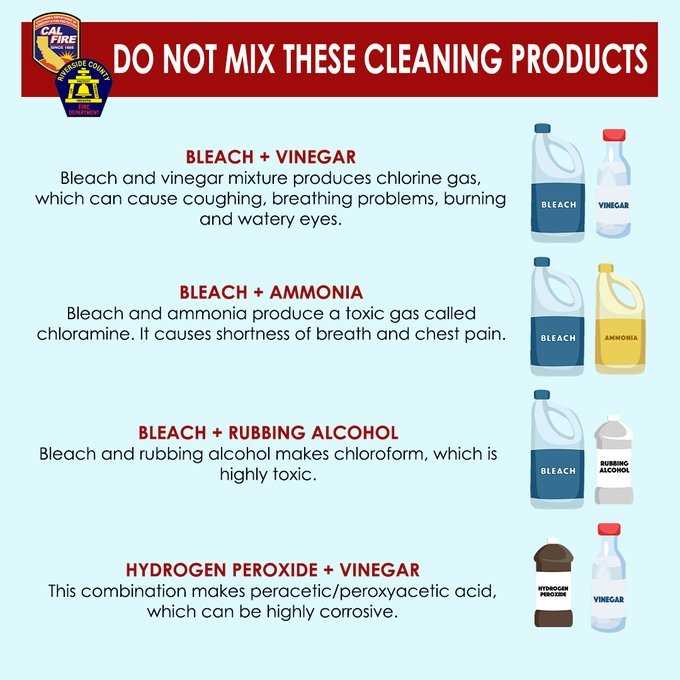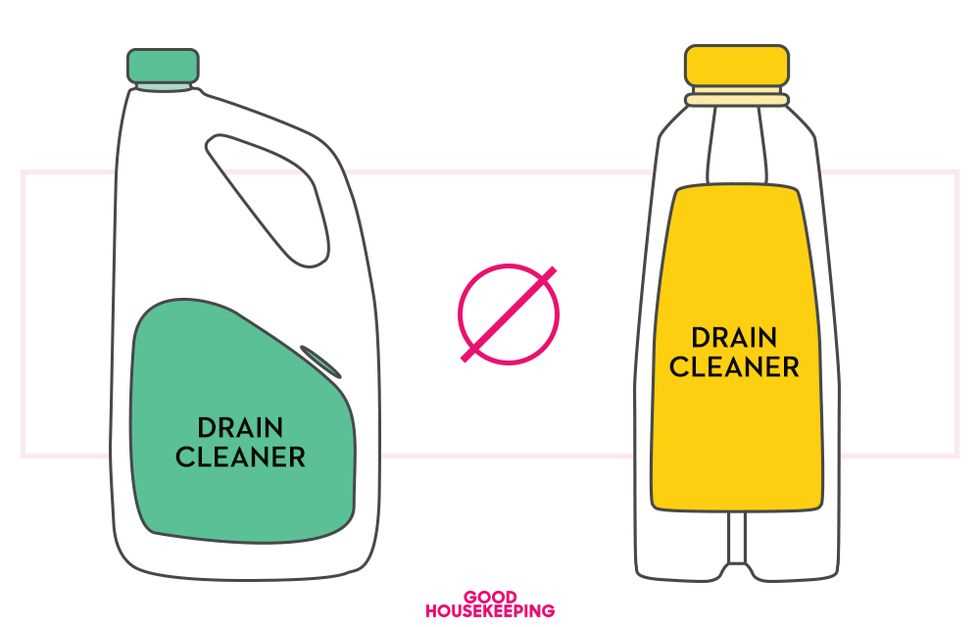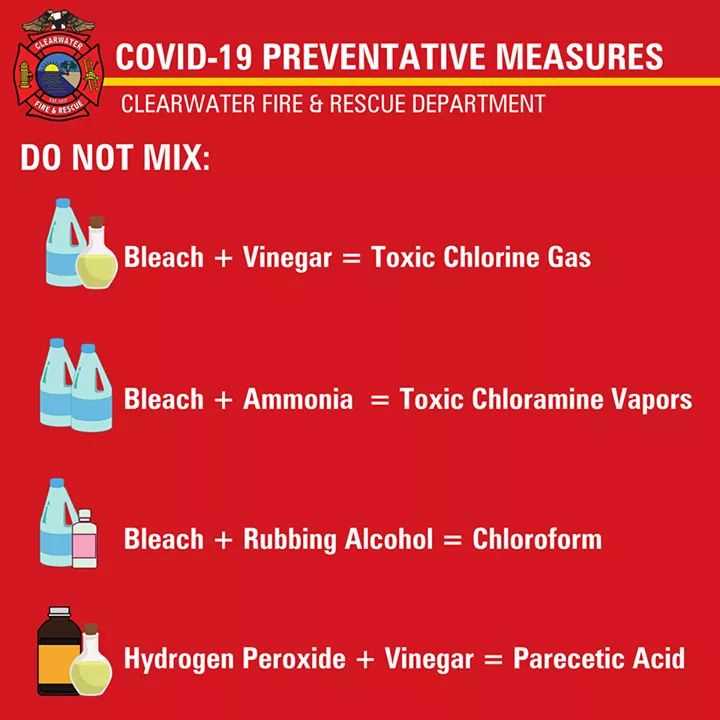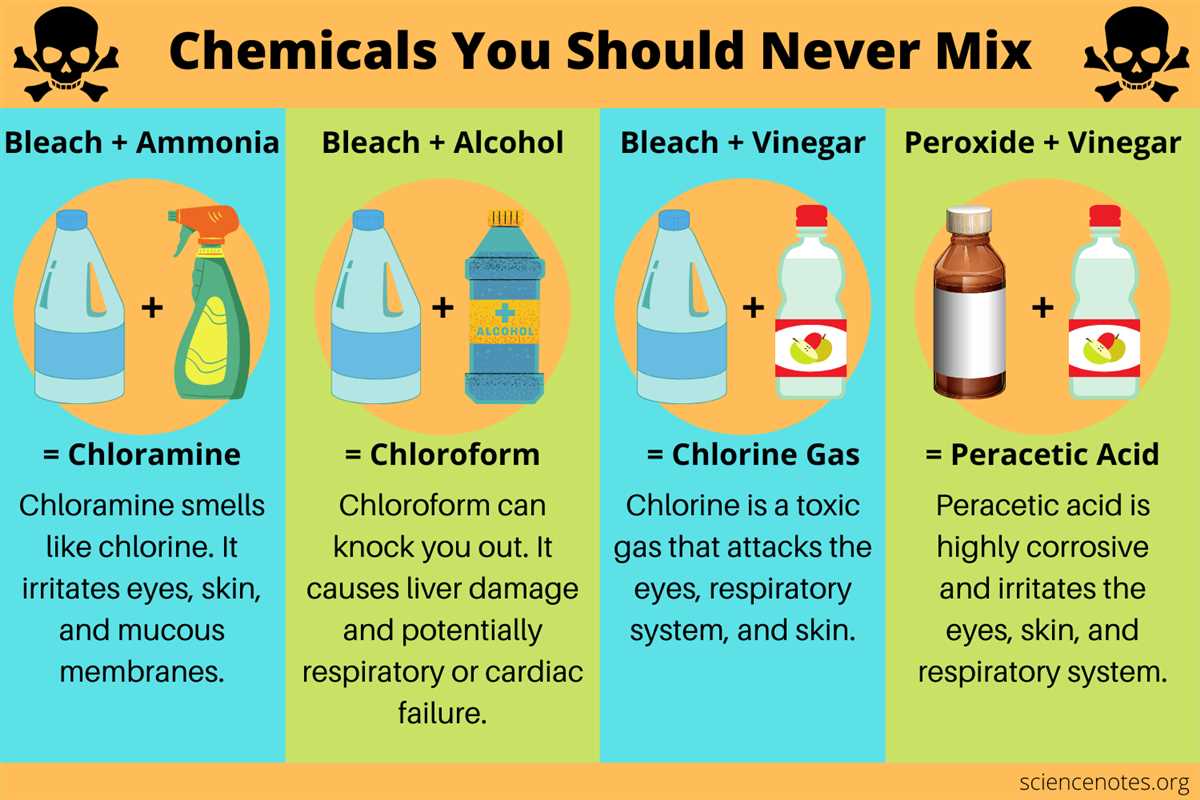




When it comes to cleaning, we often assume that more is better. However, mixing certain cleaning chemicals can have dangerous and even deadly consequences. It is important to know which chemicals should never be mixed to avoid chemical reactions that can release toxic gases or even cause explosions.
One of the most common and dangerous combinations is bleach and ammonia. Individually, both bleach and ammonia are effective cleaning agents. However, when combined, they produce a toxic gas called chloramine. Inhaling this gas can lead to coughing, shortness of breath, and chest pain. In severe cases, it can cause lung damage and even death. It is crucial to never mix bleach and ammonia together.
Another dangerous combination is bleach and vinegar. While both bleach and vinegar are commonly used for cleaning, mixing them together creates toxic chlorine gas. Inhalation of chlorine gas can cause coughing, eyes and throat irritation, and even chemical burns. To ensure your safety, it is best to use bleach and vinegar separately and never mix them.
Lastly, mixing hydrogen peroxide and vinegar is also a dangerous combination. These two cleaning agents, when mixed together, produce peracetic acid. Inhaling peracetic acid can cause irritation to the respiratory system, eyes, and skin. It is recommended to use hydrogen peroxide and vinegar separately to prevent any harmful chemical reactions.
Remember, when it comes to cleaning chemicals, it is always better to be safe than sorry. Always read and follow the product labels and never mix chemicals unless explicitly directed to do so. If you are unsure about a certain combination of cleaning chemicals, it is best to seek advice from a professional or contact the manufacturer for guidance.
Which Cleaning Chemicals Should Never Be Mixed?
When it comes to cleaning, it is important to use the right chemicals for the job. However, there are certain combinations of cleaning chemicals that should never be mixed together. Mixing these chemicals can result in dangerous reactions, including the release of toxic gases or the creation of explosive compounds. It is crucial to be aware of these chemical combinations to ensure your safety and the effectiveness of your cleaning routine.
1. Bleach and Ammonia
One of the most dangerous combinations is bleach and ammonia. Mixing these two chemicals can produce a toxic gas called chloramine, which can cause respiratory problems, chest pain, and even pneumonia. It is important to avoid using bleach and ammonia together, even in small amounts. If you need to clean with bleach, make sure the area is well-ventilated and avoid any contact with ammonia-containing products.
2. Bleach and Vinegar
Another common mistake is mixing bleach and vinegar. This combination can produce chlorine gas, which can be extremely harmful when inhaled. The reaction between bleach and vinegar also creates a compound called peracetic acid, which can irritate the eyes, skin, and respiratory system. It is best to avoid mixing bleach and vinegar and use them separately for different cleaning purposes.
3. Hydrogen Peroxide and Vinegar
Hydrogen peroxide and vinegar are both common ingredients in many cleaning products. However, when these two chemicals are combined, they create peracetic acid, which is highly corrosive and can cause damage to surfaces and irritate the skin and respiratory system. It is best to use hydrogen peroxide and vinegar separately or choose cleaning products that do not contain both of these chemicals.
4. Hydrogen Peroxide and Alcohol
Combining hydrogen peroxide and alcohol can create a chemical reaction that produces peracetic acid and can be corrosive and irritating. It is best to use these two chemicals separately and avoid mixing them together.
5. Bleach and Rubbing Alcohol

Bleach and rubbing alcohol should never be mixed. This combination can produce chloroform, a toxic compound that can cause dizziness, nausea, and even unconsciousness. Avoid mixing bleach and rubbing alcohol and use them separately for cleaning purposes.
6. Different Drain Cleaners
It is also important to avoid mixing different types of drain cleaners. These cleaners often contain highly reactive chemicals, such as acids or bases, which can react violently when combined. Mixing different drain cleaners can result in dangerous chemical reactions or the release of toxic gases. It is best to use one type of drain cleaner at a time and follow the instructions carefully.
Remember, always read the labels and instructions on cleaning products to ensure their safe and effective use. If in doubt, it is best to err on the side of caution and avoid mixing cleaning chemicals altogether. Your safety and the safety of those around you should always be the top priority when it comes to cleaning.
Understanding the Dangers of Chemical Mixing

Mixing certain cleaning chemicals can be extremely dangerous and should be avoided at all costs. Some chemicals, when combined, can produce toxic fumes, cause chemical reactions, or even result in explosions. Understanding the risks associated with chemical mixing is crucial to ensuring the safety of yourself and others.
The Importance of Proper Labeling
One of the key factors in preventing chemical mixing accidents is reading and understanding the labels on cleaning products. The labels provide important information about the ingredients and potential hazards. It is essential to follow the instructions and warnings on each product and never mix chemicals that are specifically labeled as incompatible.
Common Chemical Combination Dangers
There are several combinations of cleaning chemicals that should never be mixed due to their potentially dangerous reactions:
- Bleach and Ammonia: Mixing bleach and ammonia can produce chlorine gas, which is highly toxic and can cause severe breathing difficulties, coughing, and even death.
- Bleach and Vinegar: Mixing bleach and vinegar releases chlorine gas and toxic chloramine vapors, which can result in respiratory problems and eye irritation.
- Hydrogen Peroxide and Vinegar: Combining hydrogen peroxide and vinegar creates peracetic acid, which can irritate the respiratory system, eyes, and skin.
- Hydrogen Peroxide and Bleach: Mixing hydrogen peroxide and bleach produces a highly corrosive substance called peracetic acid, which can cause eye and skin irritation, respiratory issues, and even explosions.
- Ammonia and Bleach: Combining ammonia and bleach creates toxic chloramine vapors, which can cause respiratory problems and eye irritation.
Preventive Measures
To prevent accidental chemical mixing, it is essential to:
- Read and follow the instructions on cleaning product labels.
- Store different chemicals in separate and properly labeled containers.
- Avoid transferring chemicals into unmarked containers.
- Keep chemicals away from heat sources or open flames.
- Wear appropriate personal protective equipment (PPE) when handling chemicals.
In Case of Accidental Mixing
If you accidentally mix incompatible chemicals, follow these steps:
- Immediately leave the area and seek fresh air.
- Call emergency services if anyone is experiencing difficulty breathing or other severe symptoms.
- Do not attempt to clean up the mixture yourself unless you have the proper training and equipment.
- Contact a professional cleaning service or hazardous material handling company to handle the cleanup safely.
Understanding the dangers associated with chemical mixing and taking proper precautions can help prevent accidents and ensure the safety of yourself and others. Always be cautious and informed when working with cleaning chemicals to avoid hazardous situations.
Common Cleaning Chemicals to Avoid Mixing
When it comes to cleaning, it’s important to remember that not all cleaning chemicals are safe to mix together. Mixing certain chemicals can result in hazardous reactions that can release toxic fumes, cause fires, or even create dangerous chemical reactions.
Here are some commonly used cleaning chemicals that should never be mixed:
- Bleach and Ammonia: Mixing bleach and ammonia can produce a toxic gas called chloramine. This gas can cause coughing, shortness of breath, chest pain, and other respiratory issues. It can also be fatal if inhaled in high concentrations. Always avoid mixing bleach and ammonia.
- Bleach and Vinegar: Although vinegar is often used as a natural cleaning solution, it should never be mixed with bleach. When combined, bleach and vinegar create chlorine gas, which can cause respiratory problems, eye irritation, and coughing. It’s best to use these chemicals separately and rinse the surfaces thoroughly between uses.
- Hydrogen Peroxide and Vinegar: Mixing hydrogen peroxide and vinegar can create a corrosive acid called peracetic acid. This acid can cause skin irritation, respiratory issues, and even chemical burns. It’s safer to use these chemicals individually or choose alternative cleaning solutions.
- Hydrogen Peroxide and Bleach: Combining hydrogen peroxide and bleach can create a highly reactive and potentially explosive compound called peroxide bleach. This mixture can cause fires and explosions, and should be avoided at all costs. It’s important to handle these chemicals separately and never mix them together.
- Chlorine and Ammonia: Mixing chlorine and ammonia can produce a toxic gas called chloramine, similar to the combination of bleach and ammonia. The reaction can cause eye and respiratory irritation, coughing, and other health issues. These chemicals should always be used separately.
It’s crucial to always read and follow the instructions provided on cleaning product labels. If you’re unsure about whether two cleaning chemicals can be safely mixed, it’s best to avoid combining them altogether. Proper ventilation and protective gear like gloves and goggles should also be used when handling any cleaning chemicals.
The Risks of Mixing Bleach and Ammonia
Mixing bleach and ammonia can result in a dangerous chemical reaction that can have serious consequences. It is crucial to understand the risks associated with this combination and to avoid mixing these two chemicals.
Both bleach and ammonia are commonly used household cleaning products, but when they are mixed together, they can produce toxic gases that can be harmful or even deadly if inhaled. The combination of bleach and ammonia creates a toxic gas called chloramine, which can cause respiratory problems, eye irritation, and even chemical burns.
When bleach and ammonia are mixed, they react to form chloramine vapor. Inhalation of this vapor can cause coughing, shortness of breath, chest pain, and irritation of the respiratory system. In severe cases, it can even lead to pneumonia or other respiratory illnesses.
Not only can mixing bleach and ammonia be dangerous to your health, but it can also damage surfaces and materials. The chemical reaction between the two can produce corrosive gases that can corrode metal surfaces and bleach or discolor fabrics.
To ensure your safety and the safety of those around you, it is essential to never mix bleach and ammonia. If you need to use these cleaning products, use them separately and in well-ventilated areas. It is also crucial to read and follow the instructions and safety precautions on the labels of these products.
Always remember that mixing bleach and ammonia can have serious consequences, and it is better to be cautious and avoid any potential risks.
Combining Vinegar and Hydrogen Peroxide: A Recipe for Disaster
When it comes to cleaning, there are certain chemicals that should never be mixed. One such combination that you should absolutely avoid is vinegar and hydrogen peroxide. These two common household cleaning ingredients may seem harmless on their own, but when combined, they can create a dangerous and potentially harmful reaction.
The primary reason why vinegar and hydrogen peroxide should not be mixed is that they can produce peracetic acid, a corrosive chemical. This mixture can release harmful fumes and cause respiratory irritation, eye irritation, and even damage to your skin if exposed directly. In some cases, it can even lead to chemical burns.
It’s important to note that peracetic acid is not safe for consumption, and accidental ingestion can lead to serious health complications. Therefore, it is crucial to keep the mixture out of reach of children and pets, and clearly label any containers containing this combination.
In addition to the potential health risks, combining vinegar and hydrogen peroxide may also reduce their cleaning effectiveness. This is because their individual cleaning properties can be neutralized when mixed together. Vinegar is known for its acidic nature, which makes it effective in removing stains and killing certain types of bacteria and viruses. On the other hand, hydrogen peroxide is an oxidizing agent, which means it has the ability to break down the chemical structure of stains and kill microorganisms. When combined, these two cleaning agents may cancel out each other’s benefits, resulting in a less effective cleaning solution.
To ensure a safe and effective cleaning experience, it’s best to use vinegar and hydrogen peroxide separately. When using vinegar, dilute it with water to reduce its acidity and make it safer to use. Similarly, hydrogen peroxide should be used in its undiluted form to maximize its cleaning power.
Remember, always read and follow the instructions on product labels and make sure to store cleaning chemicals in their original containers. If you’re unsure about mixing certain cleaning chemicals, it’s better to err on the side of caution and avoid any potential risks.
Safe Alternatives for Cleaning Chemical Combinations

While it’s important to never mix certain cleaning chemicals together, there are plenty of safe alternatives that can be used to achieve effective and thorough cleaning. By using these safe alternatives, you can avoid creating dangerous chemical reactions and ensure a cleaner and safer environment.
Vinegar and Baking Soda
Vinegar and baking soda are two common household items that can be used as safe and effective alternatives for many cleaning tasks. Both vinegar and baking soda have natural cleaning properties and can be used individually or combined to tackle various cleaning challenges.
- Mixing vinegar and baking soda can create a foaming reaction that helps to remove tough stains and grime.
- Vinegar can be used to remove soap scum, clean windows and mirrors, freshen laundry, and remove odours.
- Baking soda is great for deodorizing carpets, refreshing upholstery, removing tarnish from silver, and unclogging drains.
Hydrogen Peroxide
Hydrogen peroxide is another safe alternative to consider for cleaning purposes. It has antimicrobial and disinfectant properties, making it an effective cleaner for a variety of surfaces.
- Diluted hydrogen peroxide can be used to clean cutting boards, countertops, and other food preparation surfaces.
- It can also be used to remove stains from clothing and carpets.
- Hydrogen peroxide can be an effective cleaner for bathroom surfaces, such as sinks, toilets, and shower curtains.
Lemon Juice
Lemon juice is a natural alternative that can be used for various cleaning tasks. Its acidic properties make it effective at removing grease, stains, and odours.
- Lemon juice can be used to remove hard water stains, polish copper and brass, and clean cutting boards.
- It can also be used to freshen up garbage disposals and deodorize refrigerators.
- Lemon juice mixed with salt or baking soda can create a paste for scrubbing surfaces.
Castile Soap

Castile soap is a gentle and natural soap that can be used for cleaning without the risk of dangerous chemical reactions.
- Castile soap can be used as an all-purpose cleaner for floors, countertops, and other surfaces.
- It can be used as a laundry detergent or dish soap.
- Castile soap can also be diluted and used as a body wash or hand soap.
Choosing safe alternatives like vinegar, baking soda, hydrogen peroxide, lemon juice, and castile soap can help you avoid the dangers of mixing incompatible cleaning chemicals. These alternatives not only provide effective cleaning results but also contribute to a safer and healthier environment for you and your family.
FAQ
What are some common cleaning chemicals that should never be mixed?
Some common cleaning chemicals that should never be mixed include bleach and ammonia, bleach and vinegar, bleach and rubbing alcohol, and hydrogen peroxide and vinegar.
Why should bleach and ammonia never be mixed?
Bleach and ammonia should never be mixed because the combination produces toxic fumes that can cause respiratory problems and other health issues. It is important to always use these chemicals separately and in well-ventilated areas.
Can bleach and vinegar be mixed?
No, bleach and vinegar should never be mixed. When combined, they create a toxic gas called chlorine gas. This gas can cause coughing, breathing difficulties, and other serious health problems.
What happens when bleach and rubbing alcohol are mixed together?
Mixing bleach and rubbing alcohol can create chloroform and hydrochloric acid. Chloroform is a dangerous chemical that can cause dizziness, nausea, and even unconsciousness. Hydrochloric acid is a corrosive substance that can damage surfaces and cause skin irritation.
Can hydrogen peroxide and vinegar be mixed?
No, hydrogen peroxide and vinegar should never be mixed. When combined, they create a peracetic acid, which can cause skin burns, respiratory irritation, and other health issues. It is important to use these chemicals separately.
What are the potential dangers of mixing cleaning chemicals?
Mixing cleaning chemicals can be extremely dangerous. It can lead to the release of toxic fumes, the formation of harmful gases, and even explosions in some cases. These chemical reactions can cause respiratory problems, skin burns, eye irritation, and other serious health issues.












